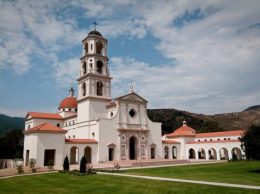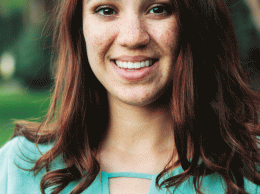
Elijah Brumback
In the foothills of the Topatopa Mountains, a small Catholic college is expanding around the summer home of the late oil baron Edward Dohney.
The next addition slated for development at Thomas Acquinas College is an $8.5 million concert and lecture hall donated by the Fritz B. Burns Foundation, one of the college’s main benefactors since it was founded in 1971.
The more than 22,000-square-foot building will be the 14th constructed at the college and will complete the academic quadrangle anchored by the Our Lady of the Most Holy Trinity Chapel.
When finished, the concert hall will put the college one building away from completing its 15-building master plan conceived when the school was first formed more than 30 years ago. The last project on the list is a gym, but there is currently no funding behind it, university officials said.
The college offers a single liberal arts degree track for its 350 students and has chipped away at its master plan one building at time. The residential campus is located on the outskirts of Santa Paula at 10000 Ojai Road.
To maintain its autonomy, the college doesn’t accept direct funding contributions from the state or federal government, and it receives no financial support from the Church.
Because the college relies solely on donors for capital projects, the campus build-out has been a slow process, said Anne Forsythe, director of college relations.
“We’ve come a long way since we were initially given the land in the ’70s,” she said. “It was entirely undeveloped except for the hacienda. We originally had modular buildings, basically trailers, when we opened.”
Located on the southwest corner of the academic quadrangle, adjacent to St. Gladys Hall, the new building will host the biweekly events that make up the college’s St. Vincent DePaul Lecture and Concert Series.
According to Thomas Aquinas President Michael McLean, the importance of the lecture and concert series to the college’s mission appealed to the Burns Foundation. The foundation’s last gift was $3.2 million for the construction of a new classroom building.
The new building, with its concert-hall acoustics, theatrical lighting and 580-person stadium seating, is a big step up from the campus dining hall currently used for events. The new space also will host productions, dances, conferences and the annual graduation ceremony.
The dining hall “wasn’t the most suitable, but it worked for years,” Forsythe said. “It wasn’t really that high up in the hierarchy of the college’s needs, but it will mean a great deal to students with a place finally suited to their work and the community in which we exist.”
The new building will allow the college to open up to the broader community in a way it couldn’t before, she said.
In addition to the main auditorium, St. Cecilia hall, as it will be known, will include a discussion room and a lower-level recreational area with a coffee shop that opens out to a terrace overlooking the future site of campus tennis courts.
The design architect for St. Cecilia Hall is Scott Boydstun of Rasmussen and Associates in Ventura, who has designed 12 of the permanent buildings on campus. The college hopes to break ground this summer to have St. Cecilia Hall ready for the 2016-2017 academic year.
To date, Thomas Aquinas has spent more than $62 million on developing its campus.
“Rassmussen and Associates, and particularly Scott Boydstun, have essentially functioned as our college architect since the 1980s and have designed 13 of 15 buildings for us,” said Peter DeLuca, vice president of finance and administration for the college. “Working together with them over that long period of time, we’ve come to understand more and more deeply what the college really wants and needs in terms of functionality and design.”
Deal of the week
Ventura Investment Co. recently closed on a 58-unit apartment complex in Camarillo. The company snapped up the property at 313 Westpark Court for about $14.8 million in an off-market deal. The complex, Villas at the Park, is part of the city’s Village at the Park master-planned community. The development includes single-family homes, townhomes, condos, apartments, commercial properties and the Camarillo Family YMCA.
“The property was built in 2009 and is among the highest quality apartment communities in Ventura County,” Ben Carter, an investment associate for the company, said in an email to the Business Times.
The firm’s focus is on multifamily investment properties in Santa Barbara and Ventura counties, and with low vacancy, the Camarillo market is strong, he said.






 Print
Print Email
Email
















